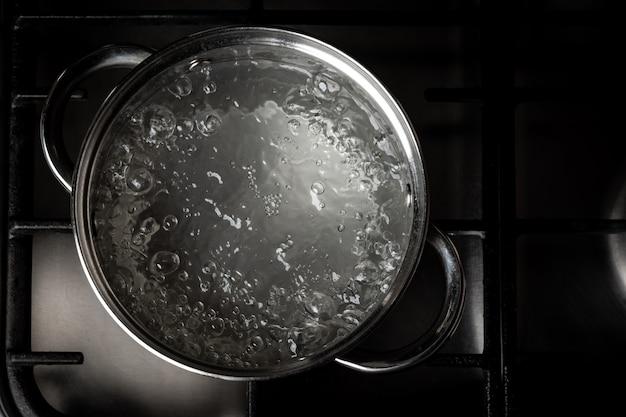Boiling water is a simple and everyday occurrence that we often take for granted. But have you ever wondered why this process is considered a physical change? In this blog post, we will delve into the fascinating world of physical changes and explore why boiling water fits into this category.
Throughout our journey, we will also address a few related questions like whether boiling water is a reversible change or if it has any connection with rain, which is another common occurrence in our lives. Plus, we’ll uncover why dissolving table salt in water is an example of a physical change. So, let’s put on our scientific hats, delve into the world of molecules, and unravel the secrets behind the physical changes that occur when water reaches its boiling point.
Title: Boiling Water: Understanding the Physical Changes

Why Boiling of Water is a Physical Change
When you think of water boiling, you probably picture a pot on the stove and steam rising up in the air. It’s a common sight in kitchens all around the world. But have you ever wondered why boiling water is considered a physical change? Let’s dive into the science behind it and uncover the fascinating reasons!
The Dance of Molecules
Water is made up of tiny particles called molecules. These molecules are in a constant state of motion, moving about and colliding with each other. When heat is applied to water, it causes the molecules to gain energy and move even faster. This increase in energy disrupts the cohesive forces between the molecules, and they start to break free from each other.
Breaking Free – The Vaporization Process
As heat continues to be applied, the water molecules reach a threshold where they have enough energy to overcome the attractive forces that hold them together in a liquid state. This is known as the boiling point of water, which is 100 degrees Celsius (212 degrees Fahrenheit) at sea level. Once the water reaches this temperature, the molecules start to transform into gas.
Can You See the Transformation
One interesting thing about the physical change of boiling water is that it occurs throughout the entire volume of the liquid. As the water molecules gain enough energy to vaporize, bubbles start to form within the liquid. These bubbles rise to the surface and release steam into the air. This is why we see the characteristic bubbling and steam when water reaches its boiling point.
What About the Chemical Composition
Now, you might be wondering if the chemical composition of water changes during the boiling process. The answer is no! Despite the dramatic transformation from a liquid to a gas, the chemical identity of water remains the same. In other words, H2O is still H2O whether it’s in liquid or gaseous form.
Time for a Quick Recap
So, to summarize, boiling water is considered a physical change because it involves the transformation of water molecules from a liquid state to a gaseous state without altering their chemical composition. The heat applied to the water increases the energy of the molecules, causing them to break free from each other and form steam bubbles. It’s a captivating process that showcases the dynamic nature of matter.
Wrap-Up
Next time you’re waiting for your pasta to cook or preparing a cup of tea, take a moment to appreciate the physical change that occurs when water reaches its boiling point. It’s not just about hot water; it’s a dance of molecules, a symphony of energy, and a fascinating scientific phenomenon. Embrace the magic happening in your kitchen as you witness the transformation from a liquid to a gas. Cheers to the physical change of boiling water!

FAQ: Why is Boiling Water Considered a Physical Change
Is Boiling Water a Reversible Change
Boiling water is indeed a reversible change. When water boils, it transforms from a liquid state into a gaseous state called water vapor. This change is reversible because when the water vapor cools down, it condenses back into a liquid form, thereby reverting to its original state. It’s like a magical disappearing act, but with an impressive comeback!
Is Rain a Physical or Chemical Change
Rain is considered a physical change rather than a chemical change. During the water cycle, water evaporates from various sources like oceans, lakes, and rivers, transforming into water vapor. When the water vapor condenses in the atmosphere, it forms clouds. The clouds cool down, leading to the collection of tiny water droplets. Eventually, these droplets combine to form raindrops, and when they fall, we experience rain. This process involves a change in the physical state of water, rather than any alteration in its chemical composition.
Why is Boiling Water a Physical Change
Boiling water is considered a physical change because it involves a change in the physical state of water. To understand this concept, let’s recall your favorite superhero: H2O! When water is heated to its boiling point (100 degrees Celsius or 212 degrees Fahrenheit at sea level), the energy is transferred to the water molecules. This increase in energy causes the water molecules to move more rapidly, breaking the forces that hold them together in the liquid state. As a result, the liquid water converts into vapor, without any alteration in its molecular structure or chemical composition. It’s like water’s secret talent – transforming into a more gaseous and carefree version of itself!
Why is Dissolving Table Salt in Water an Example of a Physical Change
The process of dissolving table salt in water exemplifies a physical change. When table salt (sodium chloride) is added to water, it dissolves due to the attractive forces between the water molecules and the sodium and chloride ions in salt. As the salt dissolves, the ions break apart from the crystal lattice and mix with the water molecules, creating a homogenous solution. Despite the change in the appearance and state of the salt, the chemical composition remains the same. It’s like a flawless dance routine where the individual dancers (ions) seamlessly blend with the ensemble (water molecules) but maintain their original identities.
Is the Boiling of Water a Physical Change
Yes, the boiling of water is considered a physical change. As mentioned earlier, the increase in temperature during boiling provides energy to the water molecules, causing them to move faster and break the intermolecular forces holding them together in the liquid state. This results in the transformation of liquid water into water vapor, without any alteration in its chemical composition. It’s like a water party where everyone gets so excited and energetic that they start leaping into the air, celebrating the joy of freedom!
What Physical Changes Can You Make to a Pencil
When it comes to pencils, there are several physical changes you can make to unleash your creative genius!
-
Sharpening the pencil: Grab that trusty pencil sharpener and give your dull pencil a makeover. By removing some of the wood casing and exposing the graphite core, you create a finely pointed tip ready to leave its mark on paper.
-
Breaking the pencil: Oops! Accidents happen, and sometimes a little too much pressure can result in a broken pencil. However, fear not! With a clean break, you now have two shorter pencil halves – perfect for those who prefer a shorter writing or drawing instrument.
-
Erasing with the pencil: Believe it or not, pencils can also be used for erasing. The rubbery eraser found on the end of some pencils allows you to make those little corrections or disappear any unwanted marks. It’s like having a trusty sidekick that helps you fix minor blunders!
-
Decorating the pencil: Let your imagination soar and personalize your pencil! Get creative with tape, paint, stickers, or even a trendy pencil topper. Express your unique style and make your pencil stand out from the crowd.
-
Lengthening the pencil: If you prefer a longer pencil, you can attach an extender or simply tape an unsharpened pencil to the end of the existing one. Now you have a writing utensil fit for a giant!
What Are Five Signs of a Physical Change
Detecting a physical change can be exciting, especially when you know the signs to look out for. Here are five telltale signs that indicate a physical change is happening:
-
Change in state or phase: If you witness a substance transforming from a solid to a liquid (like melting chocolate) or from a liquid to a gas (like boiling water), it’s a clear indicator of a physical change in progress.
-
Alteration in shape or size: When a substance undergoes a change in shape or size without any modification in its chemical composition, you’re most likely observing a physical change. For instance, stretching or crushing a piece of clay or ripping a sheet of paper all fall into this category.
-
Dissolving and mixing: When a substance dissolves in a liquid or when two substances are mixed together without any chemical reactions, it’s a sure sign of a physical change. An example would be adding sugar to your coffee – the sugar disappears, but its chemical composition remains intact.
-
Change in appearance: If you notice a visible change in the appearance of a substance, such as a change in color, texture, or transparency, it’s a strong indication of a physical change. Think of a slice of apple turning brown when exposed to air or ice melting into a refreshing drink on a warm day.
-
Reversibility: If a change can be easily reversed, meaning the substance can return to its original state through a simple physical process, it is most likely a physical change. Boiling and condensing water or freezing and melting ice are prime examples of reversible physical changes.
So, the next time you observe any of these signs, channel your inner science detective and proudly declare, “Aha! A physical change is happening!”
